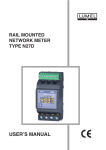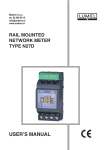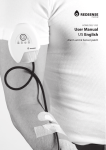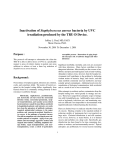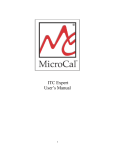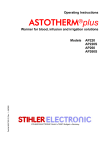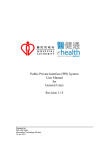Download Redsense product brochure (US)
Transcript
Redsense – reliable detection of blood loss US VERSION ‘The first clinically tested monitoring system to effectively sound the alarm on venous needle dislodgement.’ Jarl Ahlmén MD, PhD Intended use The Redsense device is intended to monitor for potential blood loss from the hemodialysis access site in hemodialysis patients undergoing continuous hemodialysis treatment at home or in a clinical setting. The device includes a blood sensor incorporated into an adhesive sensor patch. The sensor monitors potential blood leakage from the venous needle puncture site via an infrared light and will alarm if blood leakage is detected via absorption onto the device’s sensor patch. For full description please see the user manual at www.redsensemedical.com 2 This is Redsense Using patented technology developed in response to demands made by dialysis professionals, Redsense is a blood loss detection device for monitoring venous access points during hemodialysis. It can be a vital aid both in the clinic and at home, providing a `pair of eyes in the back of the head´ for the dialysis caregiver or helper. 3 Everyone is familiar with the risk of loosing blood in dialysis Hemodialysis is a form of renal therapy so common that over 1.8 million lives depends on it worldwide. Quite understandably, patients believe that hemodialysis equipment offers a high level of safety – and that in the event of venous needle dislodgement, the machine will stop pumping blood and sound an alarm1. In reality, typical dialysis equipment attempts to predict blood loss by measuring blood pressure inside the hemodialysis machine. It is interesting to note that the venous pressure monitor on the hemodialysis machines may not always react on venous needle dislodgement. 1,3,5 4 A serious venous needle dislodgement incident An elderly man arrives at his dialysis unit for a scheduled treatment. His vital signs are normal. His needles are taped securely according to unit policy, treatment begins and his blood pressure is recorded to be normal on two occasions. A little later a nurse attending to another patient notices blood dripping on the floor beneath the man’s chair. His venous needle is partially dislodged, the blood is mostly absorbed by his clothing and the chair, no alarm has sounded; he is unconscious. Blood pressure is unobtainable although a carotid pulse is present. A Hematocrit indicates 50% blood loss. Resuscitation is unsuccessful. The manufacturer’s technician evaluated the machine and no faults were found. The unit was small with an open floor plan so patients open plan; patients were constantly visible to the staff. Read more about this and other cases.2 Bleeding Significant, or even fatal, blood loss can easily occur when a venous needle becomes dislodged. It doesn’t take long. This can happen when the patient turns over or if the needle gets caught without someone noticing. Fortunalely, the vast majority of bleeding incidents are resolved quickly and efficiently by dialysis professionals who are only too aware of the risks involved. But while the chances of losing the patient may be small, waking up in a pool of blood is traumatic experience. In the US alone, 2 patients are seriously injured every day 10 and 2 patients die every week due to venous needle dislodgement. 6 It is feared that these numbers in the US could be 3 to 4 times higher. 2 No one is immune to the risk of venous needle dislodgement, it can happen at any time.12 200 needles come out during dialysis every day.11 The use of Redsense blood detecting device may help to prevent the disaster for all involved when a venous needle dislodgement occurs and will provide much needed security. 13 5 An eye on your venous access point Even when nurses outnumber patients in the clinic, venous needle dislodgement may go unnoticed until there is a pool of blood on the floor by then it may be too late.2 For patients in limited care, selfdialysis centers and home dialysis, where there is less opportunity to monitor access points, Redsense provides an alarm that is designed to promptly alert the patient, clinic personnel or the helper at home and thus becoming a vital aid. Equipped with this device, each patient can feel more comfortable that an alarm will sound if their venous needle becomes dislodged. For the care providers, too, this could bring peace of mind and freedom to move more freely around the unit. 6 Home hemodialysis Although most hemodialysis treatments still are carried out in clinics, home hemodialysis is growing both in the US and Europe and mostly in Australia and New Zeeland. Patients performing home hemodialysis have shown improvement in quality of life, morbidity and patient survival.7 It has also been shown that patients performing hemodialysis at home experience less distress then those dialyzing in center.8 The biggest obstacles for home is believed to be associated with fear of needles, self-cannulation and the fear of catastrophic events during dialysis.9 The use of Redsense allows for continuously monitoring of the venous needle, in the case of venous needle dislodgement Redsense will sound the alarm instantaneously upon contact with blood. 7 Let Redsense help keep an eye on your venous needles With the alarm unit attached to the patient and the sensor patch securely placed over the venous needle, Redsense is designed to react on blood loss immediately, enabling nurses and doctors to focus on other tangible problems of hemodialysis. Redsense will alarm when blood reaches the sensor, so the dialysis caregiver can apply appropriate action. How Redsense, helps keep an eye out for accidental bleeding Redsense is a blood loss detection device comprising of two parts: a sensor patch and a alarm unit. Connected to the alarm unit by an optical fibre, the sensor patch employs fibre optic technology to continuously monitor the venous needle access point.3 If bleeding begins, the alarm unit attached to the patient’s arm is designed to raise the alarm. Watch our simulated test on film at www.redsensemedical.com 8 9 How to use the Redsense device in a clinical setting How to use the Redsense device in a home setting 1. Attach the alarm unit to the patient in a comfortable position, towards the inside of the arm. 1. Remove the backing tape from the sensor patch and secure it over the venous needle (The centre of the patch should be directly over the access point). Ensure the sensor patch does not cover the wings of the needle. 2. Connect the sensor patch cable to the alarm unit. 3. Remove the backing tape from the sensor patch and secure it over the venous needle (The centre of the patch should be directly over the access point). Ensure the sensor patch does not cover the wings of the needle. 2. Connect the sensor patch cable to the alarm unit, hold the alarm unit in your hand, connect the sensor patch to the socket until a click is heard. 4. Activate the alarm unit by pressing the on/off switch twice. 3. Attach the alarm unit to the patient in a comfortable position , towards the inside of the arm. 5. 4. Activate the alarm unit by pressing the on/off switch twice. Now Redsense is monitoring the venous needle – indicated by the steady green light on the display - should bleeding occur the alarm unit will sound the alarm. 5. Now Redsense is monitoring the venous needle – indicated by the steady green light on the display - should bleeding occur the alarm unit will sound the alarm. For more information about the use of Redsense device please refer to instructions for use. How the sensor patch works Infrared light is sent out from the alarm unit to the sensor patch using fibre optical cable. ▼ In the event of bleeding, inner layers of the patch smear blood over the optical sensor which triggers the alarm. ▼ ▼ The sensor patch is adhesive. Notice Redsense is an alarm system for monitoring the venous needle during hemodialysis. This device is an alarm only and shall not replace existing safety procedures. 10 The Redsense story began when the Swedish county hospital of Halmstad witnessed venous needle dislodgement on a number of occasions. A few key people from the hemodialysis department discovered that these incidents were by no means unique, and that existing alarm systems were renowned for not working well.4 Advanced technology Instead of trying to measure what was going on inside the body on the hemodialysis machines, this new device was designed to monitor for blood loss directly at the access point. Using fibre optic technology designed for this exact purpose, the device proved to be highly effective and userfriendly.3 Redsense uses advanced technology embedded in an easy to use patch. The optical fibre solution provides a safe method, as there is no electronic circuit close to the access point. The Redsense sensor patch does not need to be recycled. Patented technology The concept of using an optical sensor to detect bleeding is one with many applications. For this reason, Redsense is patented as a method of detecting blood loss from the human body – not just for hemodialysis. It’s part of a patent portfolio which is already in place in the US, Canada, Europe, Asia and Asia Pacific. Redsense is a protected trademark. FAQ about Redsense At our website (www.redsensemedical.com) you will find the most common questions about Redsense. At the website you will also find studies and additional information, in order to help answer questions you may have about Redsense. References 1. Sandroni S. Venous needle dislodgement during hemodialysis: An unresolved risk of catastrophic hemorrhage. Hemodialysis International 2005; 9:102 2005/2. 2. EDTNA/ERCA Journal Club Discussion Summary. http://www.edtna-erca.org/pages/journalClub/discussion/summ2005_2.php 3. Ahlmén J, Gydell KH, Hadimeri H, Hernandez, I, Rogland B, Strömbom U (2008) A new safety device for hemodialysis Hemodialysis International 12 (2), 264–267 4. Ny teknik 15th August 2007, Issue 33 5. Polaschegg H.-D. (2010). Venous needle dislodgement: the pitfalls of venous pressure measurement and possible alternatives, a review. Journal of Renal Care 36(1), 41-48. 6.Sandroni S, et al, Catastrofic hemmorrage from venous needle dislodgement during hemodialysis, J Am Soc Nephrol 2008:19, Pub 345 7. Blagg CR. Home haemodialysis:’home, home sweet,sweet homes!”. Nephrolog 2005:10(3):206–14. 8. Cameron, J et al. Differences in Quality of Life Across Renal Replacement Therapies: A Meta Analytic comparison, Am J of Kidney Disease 2000:35 No4, 629-637. 9. Cafazzo, J-A. et al, Barriers to the Adoption on Nocturnal Hemodialysis, American Society of Nephrology 2009,ISSN:1555-9041/404-0784. 10. Patients Safety Advisory; Veteran Health Administration Warning System; Published by VA Central Office; October 21, 2008 11. Renal physicians association, US, patient survey 2007 12. Jane Hurst, RN, CLNC, EDTNA/ERCA Hamburg conference 2009 13. Jane Hurst, RN, CLNC, A costly complication: venous needle dislodgement. http://www.renalbusiness.com/articles/2010/09/ venous-needle-dislodgement.aspx?pg=3 11 Redsense Medical LTD150 N. Michigan Avenue, Suite 1950 Chicago, IL 60601, Phone: +1 877 733 0830 Fax: +1 312 276 8606 [email protected] www.redsensemedical.com RM-1-RM132 NOVEMBER 2010 Redsense Medical AB Rörkullsvägen 4 SE-302 41 Halmstad, Sweden Phone: +46 35 10 60 30 Fax: +46 35 10 60 37 [email protected] www.redsensemedical.com













